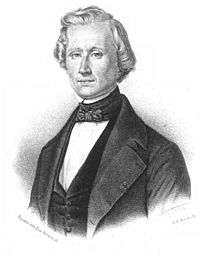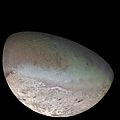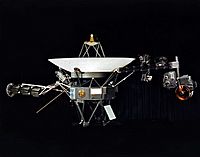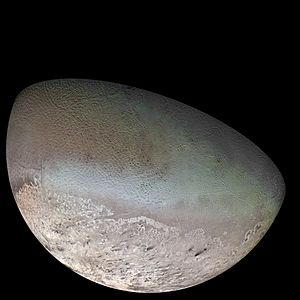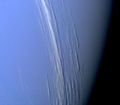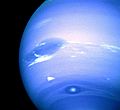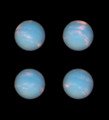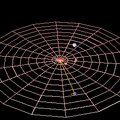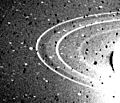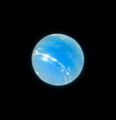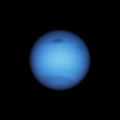Neptune facts for kids
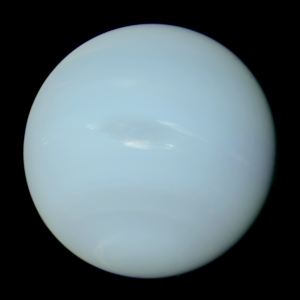
Photograph of Neptune in true colour by Voyager 2 in 1989
|
|||||||||||||
| Discovery | |||||||||||||
|---|---|---|---|---|---|---|---|---|---|---|---|---|---|
| Discovered by | |||||||||||||
| Discovery date | 23 September 1846 | ||||||||||||
| Designations | |||||||||||||
|
Named after
|
Latin Neptunus, via French Neptune | ||||||||||||
| Adjectives | Neptunian, Poseidean | ||||||||||||
| Orbital characteristics | |||||||||||||
| Epoch J2000 | |||||||||||||
| Aphelion | 30.33 AU (4.54 billion km) | ||||||||||||
| Perihelion | 29.81 AU (4.46 billion km) | ||||||||||||
| 30.07 AU (4.50 billion km) | |||||||||||||
| Eccentricity | 0.008678 | ||||||||||||
|
|||||||||||||
| 367.49 days | |||||||||||||
|
Average orbital speed
|
5.43 km/s | ||||||||||||
| 259.883° | |||||||||||||
| Inclination | 1.770° to ecliptic 6.43° to Sun's equator 0.74° to invariable plane |
||||||||||||
| 131.783° | |||||||||||||
| 2042-Sep-04 | |||||||||||||
| 273.187° | |||||||||||||
| Known satellites | 14 | ||||||||||||
| Physical characteristics | |||||||||||||
|
Mean radius
|
24,622±19 km | ||||||||||||
|
Equatorial radius
|
24,764±15 km 3.883 Earths |
||||||||||||
|
Polar radius
|
24,341±30 km 3.829 Earths |
||||||||||||
| Flattening | 0.0171±0.0013 | ||||||||||||
| 7.6187×109 km2 14.98 Earths |
|||||||||||||
| Volume | 6.253×1013 km3 57.74 Earths |
||||||||||||
| Mass | 1.02413×1026 kg 17.147 Earths 5.15×10−5 Suns |
||||||||||||
|
Mean density
|
1.638 g/cm3 | ||||||||||||
| 11.15 m/s2 1.14 g |
|||||||||||||
|
Moment of inertia factor
|
0.23 (estimate) | ||||||||||||
| 23.5 km/s | |||||||||||||
| 0.67125 d 16 h 6 m 36 s |
|||||||||||||
|
Sidereal rotation period
|
0.6713 day 16 h 6 min 36 s |
||||||||||||
|
Equatorial rotation velocity
|
2.68 km/s (9,650 km/h) | ||||||||||||
| 28.32° (to orbit) | |||||||||||||
|
North pole right ascension
|
19h 57m 20s 299.3° |
||||||||||||
|
North pole declination
|
42.950° | ||||||||||||
| Albedo | 0.290 (bond) 0.442 (geom.) |
||||||||||||
|
|||||||||||||
| 7.67 to 8.00 | |||||||||||||
| −6.9 | |||||||||||||
| 2.2–2.4″ | |||||||||||||
| Atmosphere | |||||||||||||
| 19.7±0.6 km | |||||||||||||
| Composition by volume | |||||||||||||
Neptune, is the eighth and last planet from the Sun in the Solar System. It is a gas giant. It is the fourth largest planet and third heaviest. Neptune has four rings which are hard to see from the Earth. It is 17 times heavier than Earth and is a little bit heavier than Uranus. It was named after the Roman God of the Sea.
Neptune's atmosphere is mostly made up of hydrogen and helium. It also contains small amounts of methane which makes the planet appear blue. Neptune's blue color is much brighter compared to Uranus', which has a similar amount of methane, so there might be another reason why Neptune is blue. Neptune also has the strongest winds of any planet in the solar system, measured as high as 2,100 km/h or 1,300 mph.
Neptune was discovered by the astronomers, Urbain Le Verrier and John Couch Adams. They were both honored for the discovery. The planet was the first to be discovered by mathematical calculations instead of using a telescope. Because of Uranus' odd movements in its orbit (the line which a planet follows in moving), it made astronomers search for the new planet. The planet was visited by only one spacecraft, Voyager 2 on August 25, 1989. Neptune once had a huge storm known as the "Great Dark Spot" which was discovered in 1989 by Voyager 2. However, the dark spot was not seen in 1994, and new spots were found since then. It is not known why the dark spot disappeared. Visits by more space probes have been proposed.
Contents
History
Discovery
The first possible sighting of Neptune is thought to be by Galileo as his drawings showed Neptune near Jupiter. But Galileo was not credited for the discovery since he thought Neptune was a "fixed star" instead of a planet. Because of Neptune's slow movement across the sky, Galileo's small telescope was not strong enough to detect Neptune as a planet.
In 1821, Alexis Bouvard published the astronomical tables of the orbit of Uranus. Later observations showed that Uranus was moving in an irregular way in its orbit, making some astronomers think of another large body being the cause of the irregular motions of Uranus. In 1843, John Couch Adams calculated the orbit of an eighth planet that would possibly be influencing the orbit of Uranus. He sent his calculations to Sir George Airy, the Astronomer Royal, who asked Adams for an explanation. Adams began to make a copy of the reply, but never sent it.
In 1846, Urbain Le Verrier, who was not working with Adams, made his own calculations but also failed to get much attention from French astronomers. However, in the same year, John Herschel began to support the mathematical method and encouraged James Challis to search for the planet. After much delay, Challis began his unwilling search in July 1846. Meanwhile, Le Verrier had convinced Johann Gottfried Galle to search for the planet.
Although Heinrich d'Arrest was still a student at the Berlin Observatory, he suggested that a newly drawn map of the sky, in the region of Le Verrier's predicted area, could be compared with the current sky to look for the displacement characteristic of a planet, as compared to a fixed star. Neptune was then discovered that very night on September 23, 1846, within 1° of where Le Verrier had predicted it to be, and about 10° from Adams' prediction. Challis later found out that he had seen the planet twice in August, failing to recognize it owing to his careless approach to the work.
After the news of the discovery of Neptune spread, there was also a lot of arguing between the French and the British about who was to be deserved credit for the discovery. Later, an international agreement decided that both Le Verrier and Adams together deserved credit. However, historians are now reviewing the topic after the rediscovery in 1998 of the "Neptune papers" (historical documents from the Royal Greenwich Observatory), which had seemingly been stolen by astronomer Olin Eggen for nearly three decades and were only rediscovered (in his ownership) right after his death. After reviewing the documents, some historians now think that Adams does not deserve equal credit with Le Verrier.
Naming
Shortly after its discovery, Neptune was temporarily called "the planet exterior to Uranus" or "Le Verrier's planet". The first suggestion for a name came from Galle. He proposed the name Janus. In England, Challis suggested the name Oceanus. In France, Arago suggested that the new planet be called Leverrier, a suggestion which was met with a lot of opposition outside France. French almanacs promptly reintroduced the name Herschel for Uranus and Leverrier for the new planet.
Meanwhile, on separate and different reason, Adams suggested changing the name Georgian to Uranus, while Leverrier (through the Board of Longitude) suggested Neptune for the new planet. Struve gave support of that name on December 29, 1846, to the Saint Petersburg Academy of Sciences. Soon Neptune was internationally agreed among many people and was then the official name for the new planet. In Roman mythology, Neptune was the god of the sea, identified with the Greek god, Poseidon.
Structure
Mass and composition
At 10.243×1025 kg, Neptune's mass puts the planet between Earth and the largest gas giants; Neptune has seventeen Earth masses but just 1/18th the mass of Jupiter. Neptune and Uranus are often considered to be part of a sub-class of gas giant known as "ice giants", given their smaller size and big differences in composition compared to Jupiter and Saturn. In the search for extrasolar planets, Neptune has been used as a reference to determine the size and structure of the discovered planet. Some discovered planets that have similar masses like Neptune are often called "Neptunes". just as astronomers refer to various extra-solar "Jupiters."
The atmosphere of Neptune is made up mostly of hydrogen, with a smaller amount of helium. A tiny amount of methane is also detected in the atmosphere. Important absorption bands of methane happen at wavelengths above 600 nm, in the red and infrared portion of the spectrum. This absorption of red light by the atmospheric methane gives Neptune its blue hue.
Because Neptune orbits so far from the Sun, it gets very little heat with the uppermost regions of the atmosphere at −218 °C (55 K). Deeper inside the layers of gas, however, the temperature rises slowly. Like Uranus, the source of this heating is unknown, but the differences are larger: Neptune is the farthest planet from the Sun, yet its internal energy is strong enough to create the fastest winds seen in the Solar System. Several possible explanations have been suggested, including radiogenic heating from the planet's core, the continued radiation into space of leftover heat made by infalling matter during the planet's birth, and gravity waves breaking above the tropopause.
The structure of the inside of Neptune is thought to be very similar to the structure of the inside of Uranus. There is likely to be a core, thought to be about 15 Earth masses, made up of molten rock and metal surrounded by a mixture of rock, water, ammonia, and methane. The heavy pressures keep the icy part of this surrounding mixture as solids, in spite of the large temperatures near the core. The atmosphere, extending about 10 to 20% of the way towards the center, is mostly hydrogen and helium at high altitudes. More mixtures of methane, ammonia, and water are found in the lower areas of the atmosphere. Very slowly this darker and hotter area blends into the superheated liquid interior. The pressure at the center of Neptune is millions of times more than that on the surface of Earth. Comparing its rotational speed to its degree of oblateness shows that it has its mass less concentrated towards the center unlike Uranus.
Weather and magnetic field
One difference between Neptune and Uranus is the level of meteorological activity that has been observed (seen or measured). When the Voyager spacecraft flew by Uranus in 1986, that winds on that planet were observed to be mild. When Voyager flew by Neptune in 1989, powerful weather events were observed. The weather of Neptune has extremely active storm systems. Its atmosphere has the highest wind speeds in the solar system, thought to be powered by the flow of internal heat. Regular winds in the equatorial region have speeds of around 1,200 km/h (750 mph), while winds in storm systems can reach up to 2,100 km/h, near-supersonic speeds.
In 1989, the Great Dark Spot, a cyclonic storm system the size of Eurasia, was discovered by NASA's Voyager 2 spacecraft. The storm resembled the Great Red Spot of Jupiter. However, on November 2, 1994, the Hubble Space Telescope did not see the Great Dark Spot on the planet. Instead, a new storm similar to the Great Dark Spot was found in the planet's northern hemisphere. The reason why the Great Dark Spot has disappeared is unknown. One possible theory is that heat transfer from the planet's core disrupted the atmospheric balance and existing circulation patterns. The Scooter is another storm, a white cloud group farther south than the Great Dark Spot. Its nickname was given when it was first noticed in the months leading up to the Voyager encounter in 1989: it moved faster than the Great Dark Spot. Later images showed clouds that moved even faster than Scooter. The Wizard's eye/Dark Spot 2 is another southern cyclonic storm, the second most strongest storm seen during the 1989 encounter. It originally was completely dark, but as Voyager came closer to the planet, a bright core developed and is seen in most of the highest resolution images.
Unlike other gas giants, Neptune's atmosphere shows the presence of high clouds making shadows on a thick cloud deck below. Though Neptune's atmosphere is much more active than that of Uranus, both planets are made up of the same gases and ices. Uranus and Neptune are not exactly the same type of gas giants like to Jupiter and Saturn, but are rather ice giants, meaning they have a larger solid core and are also made of ices. Neptune is very cold, with temperatures as low as −224 °C (−372 °F or 49 K) recorded at the cloud tops in 1989.
Neptune also has similarities with Uranus in its magnetosphere, with a magnetic field strongly tilted comparative to its rotational axis at 47° and offset at least 0.55 radii (about 13,500 kilometres) from the planet's physical center. Comparing the magnetic fields of the two planets, scientists think the extreme course may be characteristic of flows in the interior of the planet and not the result of Uranus' sideways rotational movement.
Neptune's Rings
Very small blue colored rings have been discovered around the blue planet, but they are not as well known as the rings of Saturn. When these rings were discovered by a team led by Edward Guinan, originally they thought that the rings may not be complete rings. However, this was proven wrong by Voyager 2. Neptune's planetary rings have a weird "clumpy" arrangement. Although the cause is currently unknown but some scientists think that it may be because of the gravitational contact with small moons that orbit near them.
Proof that the rings are incomplete first began in the mid-1980s, when stellar occultation were found to rarely show an extra "blink" just before or after the planet occulted the star. Pictures from Voyager 2 in 1989 solved the problem, when the ring system was found to have several faint rings. The farthest ring, Adams, has three famous arcs now named Liberté, Egalité, and Fraternité (Liberty, Equality, and Fraternity).
The existence of arcs is very hard to understand because the laws of motion would predict that arcs spread out into a single ring in a very short time. The gravitational effects of Galatea, a moon just inward from the ring, are now thought to have created the arcs.
Several other rings were discovered by the Voyager cameras. Also with the thin Adams Ring about 63,000 km from the center of Neptune, the Leverrier Ring is at 53,000 km and the wider, smaller Galle Ring is at 42,000 km. A very small outward expansion to the Leverrier Ring has been named Lassell; it is surrounded at its outer edge by the Arago Ring at 57,000 km.
New Earth-based observations published in 2005 appeared to show that Neptune's rings are a lot more unstable than thought before. To be exact, it looks like that the Liberté ring might disappear maybe quickly in less than 100 years. The new observations seems to puzzle our understanding of Neptune's rings into a lot of confusion.
Moons
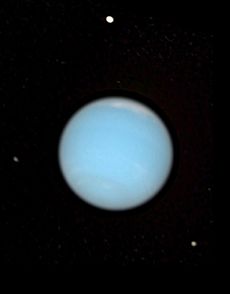
Neptune has 14 known moons. Triton is the largest Neptunian moon, comprising more than 99.5% of the mass in orbit around Neptune, and it is the only one massive enough to be spheroidal. Triton was discovered by William Lassell just 17 days after the discovery of Neptune itself. Unlike all other large planetary moons in the Solar System, Triton has a retrograde orbit, indicating that it was captured rather than forming in place; it was probably once a dwarf planet in the Kuiper belt. It is close enough to Neptune to be locked into a synchronous rotation, and it is slowly spiralling inward because of tidal acceleration. It will eventually be torn apart, in about 3.6 billion years, when it reaches the Roche limit. In 1989, Triton was the coldest object that had yet been measured in the Solar System, with estimated temperatures of 38 K (−235 °C).
Neptune's second known satellite (by order of discovery), the irregular moon Nereid, has one of the most eccentric orbits of any satellite in the Solar System. The eccentricity of 0.7512 gives it an apoapsis that is seven times its periapsis distance from Neptune.
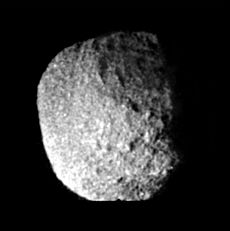
From July to September 1989, Voyager 2 discovered six moons of Neptune. Of these, the irregularly shaped Proteus is notable for being as large as a body of its density can be without being pulled into a spherical shape by its own gravity. Although the second-most-massive Neptunian moon, it is only 0.25% the mass of Triton. Neptune's innermost four moons—Naiad, Thalassa, Despina and Galatea—orbit close enough to be within Neptune's rings. The next-farthest out, Larissa, was originally discovered in 1981 when it had occulted a star. This occultation had been attributed to ring arcs, but when Voyager 2 observed Neptune in 1989, Larissa was found to have caused it. Five new irregular moons discovered between 2002 and 2003 were announced in 2004. A new moon and the smallest yet, Neptune XIV, was found in 2013. Because Neptune was the Roman god of the sea, Neptune's moons have been named after lesser sea gods.
Observation
Neptune cannot be seen with naked eye alone, since Neptune's normal brightness are between magnitudes +7.7 and +8.0, which can be out-shined by Jupiter's Galilean moons, the dwarf planet Ceres, and the asteroids 4 Vesta, 2 Pallas, 7 Iris, 3 Juno and 6 Hebe. A telescope or strong binoculars will show Neptune as a small blue dot, similar in appearance to Uranus. The blue color comes from the methane in its atmosphere. Its small obvious size has made it difficult to study visually; most telescopic data was quite limited until the arrival of the Hubble Space Telescope and large ground-based telescopes with adaptive optics.
Exploration
Voyager 2 is the only spacecraft that has visited Neptune. The spacecraft's closest approach to the planet occurred on 25 August 1989. Because this was the last major planet the spacecraft could visit, it was decided to make a close flyby of the moon Triton, regardless of the consequences to the trajectory, similarly to what was done for Voyager 1's encounter with Saturn and its moon Titan. The images relayed back to Earth from Voyager 2 became the basis of a 1989 PBS all-night program, Neptune All Night.
During the encounter, signals from the spacecraft required 246 minutes to reach Earth. Hence, for the most part, Voyager 2's mission relied on preloaded commands for the Neptune encounter. The spacecraft performed a near-encounter with the moon Nereid before it came within 4,400 km of Neptune's atmosphere on 25 August, then passed close to the planet's largest moon Triton later the same day.
The spacecraft verified the existence of a magnetic field surrounding the planet and discovered that the field was offset from the centre and tilted in a manner similar to the field around Uranus. Neptune's rotation period was determined using measurements of radio emissions and Voyager 2 also showed that Neptune had a surprisingly active weather system. Six new moons were discovered, and the planet was shown to have more than one ring.
The flyby also provided the first accurate measurement of Neptune's mass which was found to be 0.5 percent less than previously calculated. The new figure disproved the hypothesis that an undiscovered Planet X acted upon the orbits of Neptune and Uranus.
After the Voyager 2 flyby mission, the next step in scientific exploration of the Neptunian system, is considered to be a Flagship orbital mission. Such a hypothetical mission is envisioned to be possible in the late 2020s or early 2030s. However, there have been discussions to launch Neptune missions sooner. In 2003, there was a proposal in NASA's "Vision Missions Studies" for a "Neptune Orbiter with Probes" mission that does Cassini-level science. Another, more recent proposal was for Argo, a flyby spacecraft to be launched in 2019, that would visit Jupiter, Saturn, Neptune, and a Kuiper belt object. The focus would be on Neptune and its largest moon Triton to be investigated around 2029. The proposed New Horizons 2 mission (which was later scrapped) might also have done a close flyby of the Neptunian system.
Images for kids
-
The Great Dark Spot (top), Scooter (middle white cloud), and the Small Dark Spot (bottom), with contrast exaggerated.
-
In 2018, the European Southern Observatory developed unique laser-based methods to get clear and high-resolution images of Neptune from the surface of Earth.
See also
 In Spanish: Neptuno (planeta) para niños
In Spanish: Neptuno (planeta) para niños


